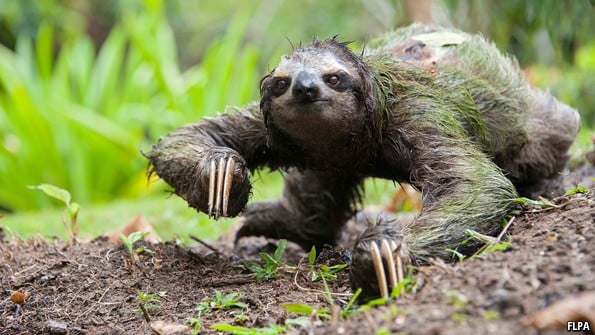Sloths spend most of their lives hanging upside down in the trees of the tropical rainforests of South America and Central America. With an odd observation, it was shown that they relatively need the help of moths in their everyday lives. But how do these moths help the sloths?
Proof of convincing studies indicates wherein sloths produce a certain type of algae in their fur and then consume it. With the help of the moths attached to their fur, a strange process of algae harvesting happens within their body.
What are Sloths?
Sloths are the sluggish tree-dwellers that are commonly found in Central and South America. They spend most of their lives in tropical rainforests. They move through the trees at a very slow rate of 40 yards per day, munching on leaves as they go along.
Theys animals have a very slow metabolic rate and spend most of their day sleeping. Surprisingly, sloths are actually good swimmers. They would sometimes drop from their perches into a body of water to paddle around. There are six species of sloths we are familiar with today; Bradypus pygmaeus, Bradypus torquatus, Bradypus tridactylus, Bradypus variegatus, Choloepus didactylus, and the Choloepus hoffmanni.
Sloths are such important elements in the ecosystem of a tropical rainforest. The sloth population is quite dependent on the health of their environment, and since tropical forests are constantly at risk, sloths are starting to lose their homes and source of food. While sloths do explore the forest ground, they don’t always do so since they are more exposed to predators that way and have little to no way to defend themselves. (Source: World Wildlife Organization)
Sloth and Moths: Mutually Beneficial
Every lock of hair of a sloth’s fur contains clashes that gather algae, providing sloths a greenish tint during the damp season. Two-toed sloths rarely descend to the forest floor. To move to a new area of trees, they often wait for the forest to flood and then swim to their next home. That fur has a moth inside it.
When a sloth goes to the ground and finishes its business, female moths will flee to the fur to lay eggs in the sloth’s dung. The eggs will hatch and the moth larvae will feast upon and live within the poop. Finally, newly emerging adult moths will take flight in search of a sloth to start the cycle all over again.
So, sloths found a way to give food to their immature ones out of the odd relationship with moths. But did sloths gain anything in retrieval?
Researchers consider that moths transport nutrients that sufficiently permit green algae to thrive in the sloth’s fur. Making use of the algae as a comfortable snack, sloths add valuable carbs, proteins, and fats into their otherwise nutrient-poor diet. And the green color of the algae also helps camouflage the sloths from potential predators.
This very special relationship, and the unplanned food source it provides, may be a primary season why three-toed sloths are so difficult to keep in detention. (Source: Gizmodo)
